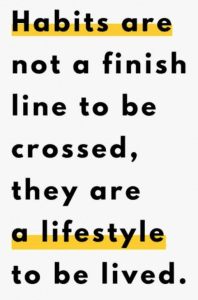Homework:
Consider what habit might be calling your name to focus on in this season and go after it. What new routine do you need to create?
Teaching:
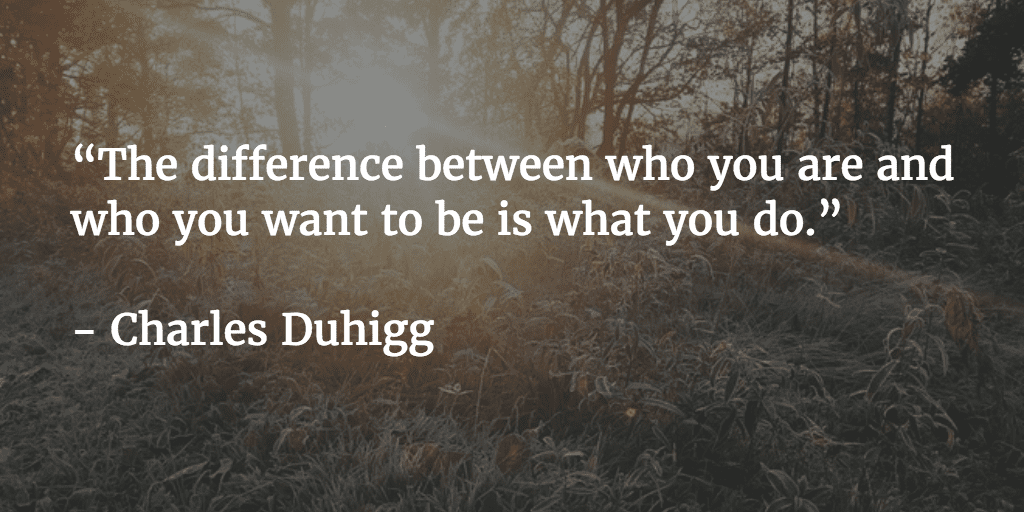
Before we dive into Food specific habits, let’s first understand HABITS.
The information below is teaching through Charles Duhigg.
So you have about 100 billion neurons inside your brain, but only a certain number of them are activated each time you think, feel or do something.
The most developed paths in your brain are your habits.
Let’s say every time you brush your teeth the following 3 neurons are activated:
- #14
- #4,765
- #9,789,908
Since you’ve been brushing your teeth every day for a long time, the path between these 3 neurons is very well established. That means the brain knows the quickest way between the three and doesn’t need a lot of energy to activate all of them.
Why is that?
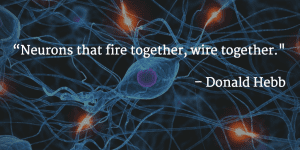
In a forest, once a Trampelpfad (a path, which has been created by people stomping along the same trail) has been established, the question is, will it turn to a proper path?
If more and more people take the Trampelpfad, it becomes broader and stronger, until eventually, it becomes the main path, and not just a side track.
The first time you ever brushed your teeth the connection between neurons #14, #4,765 and #9,789,908 was weak — basically non-existent.
Remembering to do it every night wasn’t easy, and sometimes you’d forget. Taking the Trampelpfad was tough and still took a lot of work. Now it’s a daily, automatic habit, because the neural pathway is well established. The Trampelfpad has become the main path.
This is great news, because what it implies is that you can rewire your own brain. You’re the ranger in your brain forest, and you can forge new paths, literally at will. But you can’t just pick up new habits like that, you can also get rid of old ones. Forging paths takes time. But eventually, as you take your own path again and again, it becomes the main path, just like when forming a new habit — and the old path, the previously beaten track, withers away.
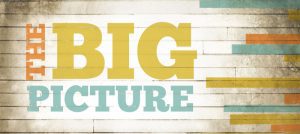
-
Habits work in 3-step loops: cue, routine, reward.
-
You can change your habits by substituting just one part of the loop, the routine.
-
Willpower is the most important habit, and you can strengthen it over time with 3 things.
Lesson 1: Habits work in 3-step loops: cue, routine, reward.
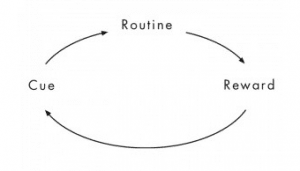
Roughly 40% of what you do happens on autopilot. Habits are your brain’s way of saving energy, so given you spend around 6 of your 16 waking hours doing things you’re not aware of, it might be worth understanding what happens here.
Duhigg discovered that at the root of all habits, like drinking your coffee every morning, lies a simple 3-part loop.

The cue is what triggers you to do the habit, for example sitting down at your kitchen table to have breakfast every morning at 7 AM.
The routine is the behavior you then automatically engage in, which, for drinking coffee, might be to go over to your coffeemaker, turn it on, and press the “large cup” button.
Lastly, you’ll receive a reward for completing the routine, such as the rich smell of your coffee, it’s hearty taste and getting to watch the steam rise from the cup as it sits on your kitchen table in the sunlight (I really love coffee, can you tell?).
Your brain’s activity only spikes twice during this loop. At the beginning, to figure out which habit to engage in, and at the end, when the link between cue and routine is reinforced.
Wait, reinforced? Aha! That’s how habits are built and the stronger this link gets, the harder it becomes to change them. But you can still do it.
Lesson 2: You can change your habits by substituting just one part of the loop, the routine.
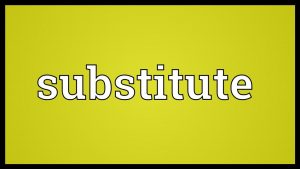
Naturally, the more often you reinforce a habit, the more embedded in your brain it gets.
In the case of the coffee, you might crave it the second you sit down at your kitchen table, and when you can’t have it that day, because the machine broke, you’ll probably get very grumpy and buy one later at work.
The trick to changing a habit then, is to switch the routine, and leave everything else in tact.
Duhigg calls this the golden rule. If you’re trying to get off caffeine, the tweak is incredibly simple: switch to decaf. You’ll still have the entire experience from A to Z, but instead of pressing a button you’re now pouring hot water over decaf coffee powder, and voilà, you won’t miss caffeine for even a single day.
Lesson 3: Your most important habit is willpower, and you can strengthen it over time in 3 ways.
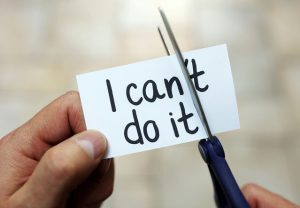
Not all habits are created equal and Duhigg says willpower is by far one of the most important ones, as it helps us do better in all aspects of life.
“What can I do I set myself up for success?”
Think about willpower like a phone battery. You charge it overnight while you sleep, then wake up to a “full battery” in the morning. Then as you use your willpower to eat healthy, be productive at work, and finally get around to cleaning, you slowly drain your “battery”.
This is why after a long, stressful day at work you can feel completely exhausted – even if you just sat at a desk all day. However, there are certain things that you can do make your battery last longer. Guess what those are?????
- Sleep
- Meditation
- Vitamins
- Clean Eating
- Exercise
- Create margin
- Hydration
Basically, everything we’re trying to make healthy habits of right now. 😉
Here are 3 uncommon ways Duhigg claims, in which you can grow your total willpower capacity over time:
- Do something that requires a lot of discipline. For example a tough wake-up regimen or strict diet will make you constantly practice delaying gratification and thus give you more willpower to exert throughout your day.
- Plan ahead for worst-case scenarios. Even just thinking about your boss yelling at you before it ever happens will help you not loose your cool when it does.
- Preserve your autonomy. Yesterday I learned that autonomy was a major part of living a passionate life. Today I learned that if you take it away, your willpower also goes down the drain. When you’re assigned tasks by someone else, which you must do, your willpower muscle tires much quicker.
It could take 21 days to make a behavior a habit, but it can also take 14, 35, or 67 days. Or any of these below or in between. How long it will take depends on a few things:
- The frequency: is it an hourly habit? A daily habit? A weekly habit? A monthly habit? An hourly have it will likely take much less time to develop. If it’s a monthly habit it can’t take any less than 2 months.
- The effort: practice makes perfect. Actually perfect doesn’t exist. Practice makes progress. The more effort you put in your planning, preparing, and pursuing this new habit, the sooner you’ll get there.
- The margin: where are you now? Where do you want to be? Naturally, the narrower the margin between your current habit and your new habit the last time it will take to adopt that you have it, providing you’re putting in the work.
Habit bundling = Current Habit + New Habit
Babit bundling is coupling mastered habits with amateur habits to master amateur habits. Habits take time to develop. but we can reduce the time it takes to develop with a simple psychic trick. Think of your current habit as a support system for your new habit. So you want to bundle a new habit with a current habit that’s related. For example; with food, while you’re trying to break up with a certain food and start eating a different one, have a little bit of both for a season. Start shifting to more of the good and less of the bad over time.
Of course it’s important to own your actions. But first, you must understand that:
Many factors influence your food choices. What you eat depends on things like location, time of day, social setting, your state of mind and physical condition just to name a few.
Eating Scripts
Many of us eat more than we need or even want because we follow eating scripts, which are habits built around eating in different situations or environment. When we repeat certain eating behaviors over and over in a single given context, we build habits and give metaphorical birth to a new behavior change. Over time, the situation or environment becomes the trigger for eating whether or not we’re even hungry. Think through and identify your danger zones with eating. Then come up with a plan to flip your proverbial eating script.
Here’s a social tip for flipping the eating script: Find someone that eats at a slower pace or just less than you. Follow their eating pattern meaning when they put their fork down you put your fork down.
Here are some strategies that makes food choices simpler on a daily basis:
- Focusing on 1 value
- Routinization
- Limitation
- Elimination
- Addition
- Subtraction
- Modification
We make roughly 300 decisions related to food per day. That’s a lot of room for error. There are two types of factors that determine what foods make it to your plate:
- Internal factors – cultural beliefs, personal biases, dietary restrictions, dietary preferences, taste, appetite, hydration, Etc
- External factors – availability, cost, convenience, other people, marketing, presentation, and so much more.
Own your environment!
One of Today’s Teaching Videos is from Coach Ben Davis of Noble Clay:
When you receive a reward, your brain releases a neurotransmitter called dopamine. Dopamine is a chemical that causes a rush of pleasure. You associate this pleasure ( reward) with the behavior that led you to receiving the pleasure. The reward acts as positive reinforcement for you to repeat the behavior.
And that’s how habits are made.
When we go go go all of the time, we eventually burn out. It’s simply not sustainable. And you’re trying to make a lifestyle change. Lifestyle changes only work if they are sustainable.
Most people think that taking a break will detract them from their gold. On the contrary. Taking a break can help you regroup, refocus, and field more on track than ever before. So change that mindset.
Weeks – Habits
Habits are just simple tools that help us keep things in check. Now let’s direct the focus to food and health specifically.
1-2 – Take a 5-minute action
3-4 – Eat slowly
- Put down your fork between bites.
- Wait until you have swallowed your mouthful of food before taking the next bite.
- Only eat until you feel about 80% full. Most likely you really are full, it just hasn’t kicked in yet.Eating too quickly leads to overeating when the food you have eaten has not yet reached your stomach and told your brain you are full. You will know you are eating too quickly if you feel stuffed about 20 minutes after you stop eating.
- Chew your food longer, more complete. Chewing create saliva. In your saliva, you have an enzyme called amylase. Amylase has one function in your body, to break down sugar. The more chewing, the more saliva, the more amylase. The more amylase, the more sugar gets partially broken down so you can digest it with less work on the part of your liver and pancreas. Contrary, your liver and pancreas will have to work harder with less chewing. This won’t hurt you in one day, but do this for decades and you will find a likely chance of fatty liver disease and prediabetes or full-blown type 2 diabetes in your future.
5-6 – Stop eating at “80% full”
Perhaps even use smaller plates.
7-8 – Eat lean protein with each meal
Eat your protein first, fat second and then the carbs last. You’ll be less likely to overeat in the carb category.
9-10 – Eat at least five servings of colorful fruits/vegetables
11-12 – Make smart carb choices (starches)
13-14- Eat healthy fats
15-16 – Eat only when you feel hungry
- Eating when you feel worried, tense, or bored also leads to overeating. Instead, call a friend or go for a walk to help you feel better.
- Give your body and your brain time to relax from the stress of daily life. Take a mental or physical break to help you feel better without turning to food as a reward.
17-18 – Record what you eat (www.myfitnesspal.com or www.cronometer.com)
19-20 – Create & use a sleep ritual (see PN Sleep guide)
21-22 – Drink only calorie-carbonated free beverages
Drink a glass of water before you even start eating.
23 – Break week (no habits)
24-25 – Use a targeted recovery strategy
26-27 – Eat whole foods only (nothing man-made)
28-29 – A little more, a little better
30-31 – Protein & colorful plants at each meal
32-33 – Practice 80% full
34-35 – Do a 5-minute mind-body scan
36-37 – Take a fitness information vacation
38-39 – 20 minutes of de-stressing
40-41 – Create and practice your fitness mission
42-43 – Choose your own adventure (sign up for something)
44-45 – Prepare for your final photoshoot/measurements
46-47 – Celebrate your progress
48-50 – Spread the love, pay it forward. Get someone into a training lifestyle who is not currently in one.
Furthered Learning Articles On Today’s Topic:
https://www.precisionnutrition.com/one-habit
https://www.precisionnutrition.com/3-diet-experiments-to-change-eating-habits


